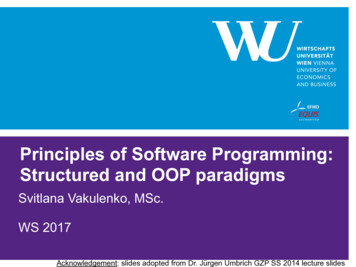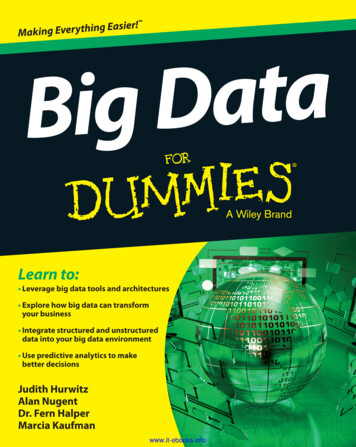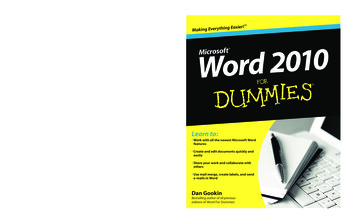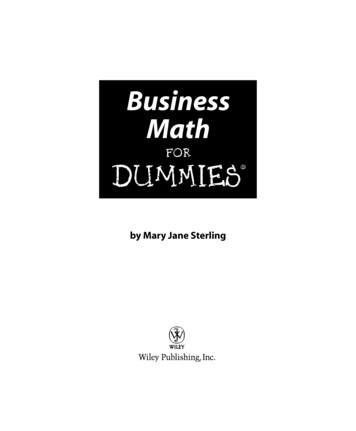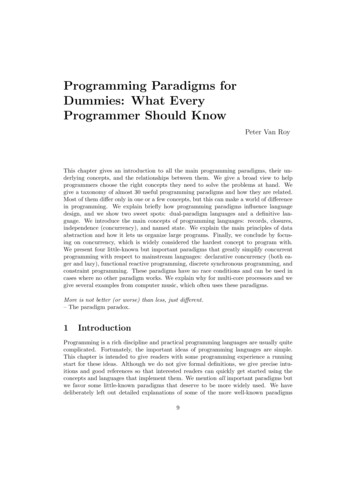
Transcription
Programming Paradigms forDummies: What EveryProgrammer Should KnowPeter Van RoyThis chapter gives an introduction to all the main programming paradigms, their underlying concepts, and the relationships between them. We give a broad view to helpprogrammers choose the right concepts they need to solve the problems at hand. Wegive a taxonomy of almost 30 useful programming paradigms and how they are related.Most of them differ only in one or a few concepts, but this can make a world of differencein programming. We explain briefly how programming paradigms influence languagedesign, and we show two sweet spots: dual-paradigm languages and a definitive language. We introduce the main concepts of programming languages: records, closures,independence (concurrency), and named state. We explain the main principles of dataabstraction and how it lets us organize large programs. Finally, we conclude by focusing on concurrency, which is widely considered the hardest concept to program with.We present four little-known but important paradigms that greatly simplify concurrentprogramming with respect to mainstream languages: declarative concurrency (both eager and lazy), functional reactive programming, discrete synchronous programming, andconstraint programming. These paradigms have no race conditions and can be used incases where no other paradigm works. We explain why for multi-core processors and wegive several examples from computer music, which often uses these paradigms.More is not better (or worse) than less, just different.– The paradigm paradox.1IntroductionProgramming is a rich discipline and practical programming languages are usually quitecomplicated. Fortunately, the important ideas of programming languages are simple.This chapter is intended to give readers with some programming experience a runningstart for these ideas. Although we do not give formal definitions, we give precise intuitions and good references so that interested readers can quickly get started using theconcepts and languages that implement them. We mention all important paradigms butwe favor some little-known paradigms that deserve to be more widely used. We havedeliberately left out detailed explanations of some of the more well-known paradigms9
Peter Van Roy(such as functional and object-oriented programming), since they already have a hugeliterature.Solving a programming problem requires choosing the right concepts. All but thesmallest toy problems require different sets of concepts for different parts. This is whyprogramming languages should support many paradigms. A programming paradigm is anapproach to programming a computer based on a mathematical theory or a coherent set ofprinciples. Each paradigm supports a set of concepts that makes it the best for a certainkind of problem. For example, object-oriented programming is best for problems with alarge number of related data abstractions organized in a hierarchy. Logic programmingis best for transforming or navigating complex symbolic structures according to logicalrules. Discrete synchronous programming is best for reactive problems, i.e., problemsthat consist of reactions to sequences of external events. Languages that support thesethree paradigms are respectively Java, Prolog, and Esterel.Popular mainstream languages such as Java or C support just one or two separateparadigms. This is unfortunate, since different programming problems need differentprogramming concepts to solve them cleanly, and those one or two paradigms often donot contain the right concepts. A language should ideally support many concepts ina well-factored way, so that the programmer can choose the right concepts wheneverthey are needed without being encumbered by the others. This style of programmingis sometimes called multiparadigm programming, implying that it is something exoticand out of the ordinary. On the contrary, in our experience it is clear that it should bethe normal way of programming. Mainstream languages are far from supporting this.Nevertheless, understanding the right concepts can help improve programming style evenin languages that do not directly support them, just as object-oriented programming ispossible in C with the right programmer attitude.This chapter is partly based on the book [50], familiarly known as CTM, which givesmuch more information on many of the paradigms and concepts presented here. But thischapter goes further and presents ideas and paradigms not covered in CTM. The codeexamples in this chapter are written in the Oz language, which is also used in CTM.Oz has the advantage that it supports multiple paradigms well, so that we do not haveto introduce more than one notation. The examples should be fairly self-explanatory;whenever anything out of the ordinary occurs we explain it in the text.Contents of this chapterLanguages, paradigms, and concepts Section 2 explains what programmingparadigms are and gives a taxonomy of the main paradigms. If your experience is limitedto one or just a few programming languages or paradigms (e.g., object-oriented programming in Java), then you will find a much broader viewpoint here. We also explain how weorganize the paradigms to show how they are related. We find that it is certainly not truethat there is one “best” paradigm, and a fortiori this is not object-oriented programming!On the contrary, there are many useful paradigms. Each paradigm has its place: eachhas problems for which it gives the best solution (simplest, easiest to reason about, ormost efficient). Since most programs have to solve more than one problem, it followsthat they are best written in different paradigms.10
Programming Paradigms for DummiesDesigning a language and its programs Section 3 explains how to design languagesto support several paradigms. A good language for large programs must support severalparadigms. One approach that works surprisingly well is the dual-paradigm language:a language that supports one paradigm for programming in the small and another forprogramming in the large. Another approach is the idea of designing a definitive language.We present an example design that has proved itself in four different areas. The designhas a layered structure with one paradigm in each layer. Each paradigm is carefullychosen to solve the successive problems that appear. We explain why this design is goodfor building large-scale software.Programming concepts Section 4 explains the four most important concepts in programming: records, lexically scoped closures, independence (concurrency), and namedstate. Each of these concepts gives the programmer an essential expressiveness thatcannot be obtained in any other way. These concepts are often used in programmingparadigms.Data abstraction Section 5 explains how to define new forms of data with their operations in a program. We show the four kinds of data abstractions: objects and abstractdata types are the two most popular, but there exist two others, declarative objects andstateful abstract data types. Data abstraction allows to organize programs into understandable pieces, which is important for clarity, maintenance, and scalability. It allowsto increase a language’s expressiveness by defining new languages on top of the existinglanguage. This makes data abstraction an important part of most paradigms.Deterministic concurrent programming Section 6 presents deterministic concurrent programming, a concurrent model that trades expressiveness for ease of programming. It is much easier to program in than the usual concurrent paradigms, namelyshared-state concurrency and message-passing concurrency. It is also by far the easiestway to write parallel programs, i.e., programs that run on multiple processors such asmulti-core processors. We present three important paradigms of deterministic concurrency that deserve to be better known. The price for using deterministic concurrency isthat programs cannot express nondeterminism, i.e., where the execution is not completelydetermined by the specification. For example, a client/server application with two clientsis nondeterministic since the server does not know from which client the next commandwill come. The inability to express nondeterminism inside a program is often irrelevant,since nondeterminism is either not needed, comes from outside the program, or can belimited to a small part of the program. In the client/server application, only the communication with the server is nondeterministic. The client and server implementationscan themselves be completely deterministic.Constraint programming Section 7 presents the most declarative paradigm of ourtaxonomy, in the original sense of declarative: telling the computer what is needed instead of how to calculate it. This paradigm provides a high level of abstraction for solvingproblems with global conditions. This has been used in the past for combinatorial problems, but it can also be used for many more general applications such as computer-aidedcomposition. Constraint programming has achieved a high degree of maturity since its11
Peter Van RoyFigure 1. Languages, paradigms, and conceptsorigins in the 1970s. It uses sophisticated algorithms to find solutions that satisfy globalconditions. This means that it genuinely delivers on its ambitious claims.Conclusions and suggestions for going further Section 8 concludes by reiteratingwhy programming languages should support several paradigms. To understand the “soul”of each paradigm and to gain experience programming with different paradigms, werecommend the use of a multiparadigm language. A multiparadigm language permitsprogramming in each paradigm without interference from other paradigms. The twomost extensive multiparadigm languages are the dynamically typed language Oz [50]and the statically typed language Alice [38].2Languages, paradigms, and conceptsThis section gives the big picture of programming paradigms, the languages that realizethem, and the concepts they contain. There are many fewer programming paradigmsthan programming languages. That is why it is interesting to focus on paradigms ratherthan languages. From this viewpoint, such languages as Java, Javascript, C#, Ruby, andPython are all virtually identical: they all implement the object-oriented paradigm withonly minor differences, at least from the vantage point of paradigms.Figure 1 shows the path from languages to paradigms and concepts. Each programming language realizes one or more paradigms. Each paradigm is defined by a set ofprogramming concepts, organized into a simple core language called the paradigm’s kernel language. There are a huge number of programming languages, but many fewerparadigms. But there are still a lot of paradigms. This chapter mentions 27 differentparadigms that are actually used. All have good implementations and practical applications. Fortunately, paradigms are not islands: they have a lot in common. We present ataxonomy that shows how paradigms are related.12
Programming Paradigms for S expressionData structures onlyTuring complete procedure cell (state)First ? Yes NoGuardedcommandprogramming closureScheme, MLRelational & rogrammingHaskellConstraint CLP, ILOG Solver threadPipes, MapReduce thread single assignmentLIFE, AKL by need synchronization by needsynchronizationLazydataflowprogrammingLazy urrentprogrammingOz, Alice, CurryOz, Alice, CurryLogic andconstraintsADTimperativeprogramming cellScheme, MLHaskell, ML, ECLU, OCaml, Oz thread single assign. nondeterministic portchoice(channel)Monotonic by needsynchron.Prolog, SQLembeddings solverConcurrentconstraintprogramming(unforgeable amming searchFunctionalUnnamed state (seq. or conc.) searchSNOBOL, Icon, Prolog name continuationDeterministiclogic programmingPascal, CImperativesearchprogrammingDijkstra’s GCLFunctionalprogramming unification(equality)Imperativeprogramming nondet. choiceNonmonotonicdataflowprogrammingMulti agentdataflowprogrammingConcurrent logicprogrammingOz, Alice, AKL port(channel)Event loopprogrammingE in one vat threadMulti agentprogrammingErlang, AKL local cell synch. on partial terminationFunctional reactiveprogramming (FRP)Active objectprogrammingContinuous synchronousprogrammingObject capabilityprogrammingFrTime, Yampa clocked computationDiscrete synchronousprogrammingEsterel, Lustre, SignalDataflow andmessage passingNondet. state closureSequentialobject va, OCaml threadMessage passingconcurrentprogrammingOz, Alice, Curry, Excel,AKL, FGHC, FCP cell(state)Concurrentobject orientedprogrammingShared stateconcurrentprogrammingSmalltalk, Oz,Java, Alice logCSP, Occam,E, Oz, Alice,publish/subscribe,tuple space (Linda)SQL embeddingsMessage passingShared stateSoftwaretransactionalmemory (STM)Named stateLessMoreExpressiveness of stateFigure 2. Taxonomy of programming paradigms2.1Taxonomy of programming paradigmsFigure 2 gives a taxonomy of all major programming paradigms, organized in a graphthat shows how they are related [55]. This figure contains a lot of information and rewards careful examination. There are 27 boxes, each representing a paradigm as a setof programming concepts. Of these 27 boxes, eight contain two paradigms with differentnames but the same set of concepts. An arrow between two boxes represents the conceptor concepts that have to be added to go from one paradigm to the next. The conceptsare the basic primitive elements used to construct the paradigms. Often two paradigmsthat seem quite different (for example, functional programming and object-oriented programming) differ by just one concept. In this chapter we focus on the programmingconcepts and how the paradigms emerge from them. With n concepts, it is theoreticallypossible to construct 2n paradigms. Of course, many of these paradigms are useless inpractice, such as the empty paradigm (no concepts)1 or paradigms with only one concept.A paradigm almost always has to be Turing complete to be practical. This explains whyfunctional programming is so important: it is based on the concept of first-class function,1 Similar reasoning explains why Baskin-Robbins has exactly 31 flavors of ice cream. We postulatethat they have only 5 flavors, which gives 25 1 31 combinations with at least one flavor. The 32ndcombination is the empty flavor. The taste of the empty flavor is an open research question.13
Peter Van Royor closure, which makes it equivalent to the λ-calculus which is Turing complete. Of the2n possible paradigms, the number of practically useful paradigms is much smaller. Butit is still much larger than n.When a language is mentioned under a paradigm in Figure 2, it means that part ofthe language is intended (by its designers) to support the paradigm without interferencefrom other paradigms. It does not mean that there is a perfect fit between the languageand the paradigm. It is not enough that libraries have been written in the language tosupport the paradigm. The language’s kernel language should support the paradigm.When there is a family of related languages, usually only one member of the family ismentioned to avoid clutter. The absence of a language does not imply any kind of valuejudgment. There are just too many good languages to mention them all.Figure 2 shows two important properties of the paradigms: whether or not they haveobservable nondeterminism and how strongly they support state. We now discuss eachof these properties in turn.Observable nondeterminismThe first key property of a paradigm is whether or not it can express observable nondeterminism. This is identified in Figure 2 by boxes with a heavy or light border. We recallthat nondeterminism is when the execution of a program is not completely determinedby its specification, i.e., at some point during the execution the specification allows theprogram to choose what to do next. During the execution, this choice is made by a partof the run-time system called the scheduler. The nondeterminism is observable if a usercan see different results from executions that start at the same internal configuration.This is highly undesirable. A typical effect is a race condition, where the result of aprogram depends on precise differences in timing between different parts of a program(a “race”). This can happen when the timing affects the choice made by the scheduler.But paradigms that have the power to express observable nondeterminism can be usedto model real-world situations and to program independent activities.We conclude that observable nondeterminism should be supported only if its expressive power is needed. This is especially true for concurrent programming. For example, the Java language can express observable nondeterminism since it has both namedstate and concurrency (see below). This makes concurrent programming in Java quitedifficult [29]. Concurrent programming is much easier with the declarative concurrentparadigm, in which all programs are deterministic. Sections 6 and 7 present four important concurrent paradigms that do not have observable nondeterminism.Named stateThe second key property of a paradigm is how strongly it supports state. State is theability to remember information, or more precisely, to store a sequence of values in time.Its expressive power is strongly influenced by the paradigm that contains it. We distinguish three axes of expressiveness, depending on whether the state is unnamed or named,deterministic or nondeterministic, and sequential or concurrent. This gives eight combinations in all. Later in this chapter we give examples of many of these combinations. Notall of the combinations are useful. Figure 3 shows some useful ones arranged in a lattice;14
Programming Paradigms for DummiesDeclarative paradigms (relational and functional)!Expressiveness of state!Less!unnamed, deterministic, sequential!named, deterministic, sequential!unnamed, deterministic, concurrent!Imperative programming!Deterministic concurrency!named, nondeterministic, sequential!unnamed, nondeterministic, concurrent!Guarded command programming!Concurrent logic programming!named, nondeterministic, concurrent!More!Message-passing and shared-state concurrency!Figure 3. Different levels of support for stateadjacent boxes differ in one coordinate.2 One intriguing box shown is Dijkstra’s guardedcommand language (GCL) [14]. It has named state and nondeterministic choice in asequential language. It uses nondeterministic choice to avoid overspecifying algorithms(saying too much about how they should execute).The paradigms in Figure 2 are classified on a horizontal axis according to how stronglythey support state. This horizontal axis corresponds to the bold line in Figure 3. Let usfollow the line from top to bottom. The least expressive combination is functional programming (threaded state, e.g., DCGs in Prolog and monads in functional programming:unnamed, deterministic, and sequential). Adding concurrency gives declarative concurrent programming (e.g., synchrocells: unnamed, deterministic, and concurrent). Addingnondeterministic choice gives concurrent logic programming (which uses stream mergers:unnamed, nondeterministic, and concurrent). Adding ports or cells, respectively, givesmessage passing or shared state (both are named, nondeterministic, and concurrent).Nondeterminism is important for real-world interaction (e.g., client/server). Named stateis important for modularity (see Section 4.4).Both observable nondeterminism and named state are cases where it is important tochoose a paradigm that is expressive enough, but not too expressive (see epigram at thehead of the chapter). Each of these two concepts is sometimes needed but should be leftout if not needed. The point is to pick a paradigm with just the right concepts. Too fewand programs become complicated. Too many and reasoning becomes complicated. Wewill give many examples of this principle throughout this chapter.2.2Computer programming and system designFigure 4 gives a view of computer programming in the context of general system design.This figure adds computer programming to a diagram taken from Weinberg [56]. Thetwo axes represent the main properties of systems: complexity (the number of basicinteracting components) and randomness (how nondeterministic the system’s behavioris). There are two kinds of systems that are understood by science: aggregates (e.g., gas2 Two of the eight possible combinations are not shown in the figure. We leave it to the reader todiscover them and find out if they make any sense!15
Peter Van RoyComputer programmingComputer programmingFigure 4. Computer programming and system design (adapted from Weinberg [56])molecules in a box, understood by statistical mechanics) and machines (e.g., clocks andwashing machines, a small number of components interacting in mostly deterministicfashion). The large white area in the middle is mostly not understood. The science ofcomputer programming is pushing inwards the two frontiers of system science: computerprograms can act as highly complex machines and also as aggregates through simulation.Computer programming permits the construction of the most complex systems.Modern programming languages have evolved over more than five decades of experience in constructing programmed solutions to complex, real-world problems. Modernprograms can be quite complex, reaching sizes measured in millions of lines of sourcecode, written by large teams of programs over many years. In our view, languages thatscale to this level of complexity are successful in part because they model some essentialfactors of how to construct complex systems. In this sense, these languages are not justarbitrary constructions of the human mind. They explore the limits of complexity in amore objective way. We would therefore like to understand them in a scientific way, i.e.,by understanding the basic concepts that compose the underlying paradigms and howthese concepts are designed and combined. This is the deep justification of the creativeextension principle explained below.2.3Creative extension principleConcepts are not combined arbitrarily to form paradigms. They can be organized according to the creative extension principle. This principle was first defined by Felleisen[18] and independently rediscovered in [50]. It gives us a guide for finding order in thevast set of possible paradigms. In a given paradigm, it can happen that programs become complicated for technical reasons that have no direct relationship to the specificproblem that is being solved. This is a sign that there is a new concept waiting to bediscovered. To show how the principle works, assume we have a simple sequential functional programming paradigm. Then here are three scenarios of how new concepts canbe discovered and added to form new paradigms:16
Programming Paradigms for DummiesFigure 5. How adding exceptions to a language can simplify programs If we need to model several independent activities, then we will have to implementseveral execution stacks, a scheduler, and a mechanism for preempting executionfrom one activity to another. All this complexity is unnecessary if we add oneconcept to the language: concurrency. If we need to model updatable memory, that is, entities that remember and updatetheir past, then we will have to add two arguments to all function calls relative tothat entity. The arguments represent the input and output values of the memory.This is unwieldy and it is also not modular because the memory travels throughoutthe whole program. All this clumsiness is unnecessary if we add one concept to thelanguage: named state. If we need to model error detection and correction, in which any function can detectan error at any time and transfer control to an error correction routine, then weneed to add error codes to all function outputs and conditionals to test all functioncalls for returned error codes. All this complexity is unnecessary if we add oneconcept to the language: exceptions. Figure 5 shows how this works.The common theme in these three scenarios (and many others!) is that we need to dopervasive (nonlocal) modifications of the program in order to handle a new concept. Ifthe need for pervasive modifications manifests itself, we can take this as a sign that thereis a new concept waiting to be discovered. By adding this concept to the language we nolonger need these pervasive modifications and we recover the simplicity of the program.The only complexity in the program is that needed to solve the problem. No additionalcomplexity is needed to overcome technical inadequacies of the language. Both Figure 2and [50] are organized according to the creative extension principle.3Designing a language and its programsA programming language is not designed in a vacuum, but for solving certain kinds ofproblems. Each problem has a paradigm that is best for it. No one paradigm is best for allproblems. That is why it is important to choose carefully the paradigms supported by the17
Peter Van Roylanguage. We will look at two interesting cases: languages that support two paradigms(Section 3.1) and layered languages (Section 3.2). The layered language we present is aparticularly interesting one because almost the same layered structure appears in fourdifferent areas.3.1Languages that support two paradigmsMany languages support two paradigms, typically one for programming in the smalland another for programming in the large. The first paradigm is chosen for the kind ofproblem most frequently targeted by the language. The second paradigm is chosen tosupport abstraction and modularity and is used when writing large programs. Here area few examples: Prolog: The first paradigm is a logic programming engine based on unification anddepth-first search. The second paradigm is imperative: the assert and retract operations which allow a program to add and remove program clauses. Prolog datesfrom 1972, which makes it an old language. Recent developments in modeling languages based on advanced search algorithms advance both the logic programmingand imperative programming sides. Modern Prolog implementations have addedsome of these advances, e.g., support for constraint programming and a modulesystem. Modeling languages (e.g., Comet, Numerica [48]): The first paradigm is a solver:constraint programming (see Section 7), local search (see the chapter by PhilippeCodognet [8]), satisfiability (SAT solvers), and so forth. The second paradigm isobject-oriented programming. Solving libraries (e.g., Gecode): The first paradigm is a solver library based onadvanced search algorithms, such as Gecode [43, 47]. The second paradigm is addedby the host language, e.g., C and Java support object-oriented programming. Language embedding (e.g., SQL): SQL already supports two paradigms: a relationalprogramming engine for logical queries of a database and a transactional interfacefor concurrent updates of the database. The host language complements this bysupporting object-oriented programming, for organization of large programs. Thisexample goes beyond two paradigms to show a design with three complementaryparadigms.3.2A definitive programming languageAt some point in time, language research will give solutions that are good enough thatresearchers will move on to work at higher levels of abstraction. This has already arrivedfor many subareas of language design, such as assembly languages and parsing algorithms. In the 1970s, compiler courses were built around a study of parsing algorithms.Today, parsing is well understood for most practical purposes and compiler design hasmoved on. Today’s compiler courses are built around higher level topics such as dataflowanalysis, type systems, and language concepts. We postulate that this kind of evolutionis happening with language design as well.18
Programming Paradigms for DummiesLayerErlang [6, 5]Functionalprogramming(see Section 4.2)Deterministicconcurrency(see Section 6)Message-passingconcurrency(see Section 4.3)Shared-stateconcurrency(see Section 4.4)A process is a recursive functionin its own thread,employingclosures for hot codeupdate(not supported)Faulttoleranceby isolation, faultdetectionwithmessagesGlobal database(Mnesia)keepsconsistent statesLanguage projectE [32, 31]Distrib. Oz [10]An object is arecursive function with a localstateDeterministicexecution of allobjects in onevat (process)Security by isolation, messagesbetween objectsin different vats(not supported)Functions,procedures, classes,and componentsare closures withefficient distrib.protocolsDataflow concurrency with efficient protocol fordataflow variablesAsynchronousmessageprotocols to hidelatencyCoherent globalstate protocols;transactions forlatency and faulttoleranceDidactic Oz [50]Closures are thefoundation of allparadigmsConcurrency is aseasy as functionalprogramming, norace conditionsMulti-agent programming is expressive and easyto programNamed state formodularityTable 1. Layered structure of a definitive programming languageThis section presents the structure of one possible definitive language [52]. We studyfour research projects that were undertaken to solve four very different problems. Thesolutions achieved by all four projects are significant contributions to their respectiveareas. All four projects considered language design as a key factor to achieve success. Thesurprise is that all four projects ended up using languages with very similar structures.Table 1 shows the common properties of the programming language invented in eachof the four projects. The common language has a layered structure with four layers: astrict functional core, followe
Dummies: What Every Programmer Should Know Peter Van Roy This chapter gives an introduction to all the main programming paradigms, their un-derlying concepts, and the relationships between them. We give a broad view to help programmers choose the right concepts they need to solve the problems at hand. We







